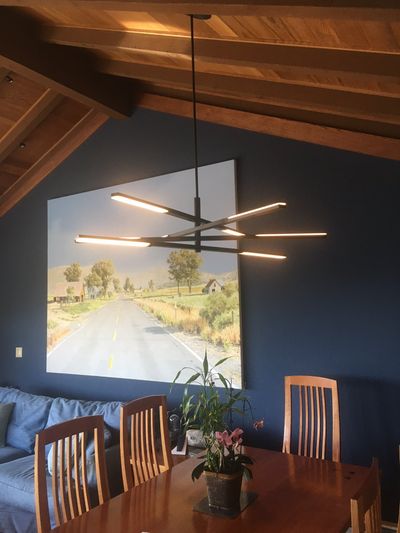The 4 Types of Lighting
1) Ambient lighting – this is indirect light that evenly illuminates a room. Ambient lights include natural light, pendants, and overhead fixtures.
2)
Task lighting – this type of lighting spotlights your work area, whether it’s a desk, table for doing craft-work or the counter that you prepare food on. Task lighting includes reading lamps and under-counter or under-cabinet lights.
3)
Accent lighting – this is used to highlight your architecture or favourite design accessories. Accent lights include track lights or adjustable recessed lights.
4)
Decorative lights – are used to make large rooms seem less overwhelming and to add a touch of personality. These lights include lamps and chandeliers.
Interior Lighting Trends
Natural Materials
One way to bring the outdoors inside your home is to use natural materials for your interior lighting. By adding shades that are made from wicker, bamboo, cork, or even clay, you can create a unique minimalist design to any space. These types of interior lights are perfect for cabins, patios, and anyone who loves nature.
Vintage Edison Bulbs
Although they do not create a ton of light, vintage Edison bulbs add a retro style that can be both rustic and modern depending on other décor in the room. The soft warm glow will add an intimate feel or combine a whole system of lights to illuminate a whole room. You can also buy a stronger lightbulb and use an industrial fixture to keep the industrial look and feel.
LED Lighting
LEDs continue to get cheaper, more natural looking, and available with more variety. This type of interior lighting is a more efficient and environmentally friendly option than traditional incandescent bulbs. From single lightbulbs to rope lights that can add accent lighting behind or underneath an object, look for LED lighting to continue to grow in popularity for use inside the home.
PLANNING THE LIGHTING SCHEME FOR EACH ROOM
- Itemize the activities that occur in each room. For example - reading, preparing food, craft and hobby work, homework, grooming, doing or folding laundry, etc.
- State the mood or ambiance that you want to produce or each space. Do you want a relaxed and laid back mood? Do you want people to be alert and focused? Do you want a feeling of security? Etc.
- Identify any decorative elements you want to emphasize, such as artwork or wall textures.
- Recognize where you have areas with dark wall colors and finishes. Supplemental lighting may be needed for these walls as darker areas absorb more light than those with lighter colors and finishes.
There is a common misconception that you need to light a room in its entirety. This is not true. Interior designers suggest incorporating lighting from each lighting type. This is called layering and includes using lights from any of the four types in a way that they blend well and create an ambience for the room. It is best to decide on a light source and then decide how to disperse it in the room. One way to do this is to look at various lampshades as choosing the right one can make all the difference to how light is diffused in your room.
Contact us today to get started! We have an A+ rating with the Better Business Bureau, and we are licensed, bonded, and insured for both your protection and ours.


